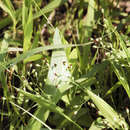Comprehensive Description
provided by North American Flora
Panicum leibergii (Vasey) Scribn.; Nash, in Britt. & Brown,
111. Fl. 3: 497. 1898.
Panicum scoparium Leibergii Vasey, Bull. U. S. Dep. Agr. Bot. 8: 32. 1889.
Panicum Scribnerianum Leibergii Scribn. ; T. A. Williams, Bull. U. S. Dep. Agr. Agrost. 6:*32. 1897.
Milium Leibergii Uinell, Am. Midi. Nat. 4: 213. 1915.
Vernal phase dull-green, in clumps of few to several slender culms, 25-75 cm. high, erect from a more or less geniculate base, pilose to merely scabrous; leaf-sheaths shorter than the internodes, papillose-hispid with spreading hairs; ligule almost obsolete; blades ascending or erect, rather thin, 6-15 cm. long, 7-15 mm. wide, narrowed toward the rounded base, acuminate, papillose-hispid on both surfaces, often sparsely so above, papillose-ciliate from one third to half their length; panicles finally long-exserted, 8-15 cm. long, less than half as wide, the flexuous branches narrowly ascending or somewhat spreading at anthesis; spikelets 3.7-4 mm. long, 1.8-2 mm. wide, oblong-obovate, turgid, strongly papillose-hispid with spreading hairs; first glume more than half the length of the spikelet, pointed; second glume and sterile lemma subequal, covering the fruit at maturity or the lemma slightly exceeding it; fruit 3 mm. long, 1.7-1.8 mm. wide, obovate-oval.
Autumnal phase more or less leaning, sparingly branching from the middle and lower nodes late in summer, the branches mostly simple, erect, the blades scarcely reduced, usually exceeding the short-exserted panicles.
Type locality: Plymouth County, Iowa.
Distribution: New York' to Manitoba, and south to Ohio and Kansas.
- bibliographic citation
- George Valentine Nash. 1915. (POALES); POACEAE (pars). North American flora. vol 17(3). New York Botanical Garden, New York, NY
Physical Description
provided by USDA PLANTS text
Perennials, Terrestrial, not aquatic, Rhizomes present, Stems nodes swollen or brittle, Stems erect or ascending, Stems caespitose, tufted, or clustered, Stems terete, round in cross section, or polygonal, Stem internodes hollow, Stems with inflorescence less than 1 m tall, Stems, culms, or scapes exceeding basal leaves, Leaves mostly basal, below middle of stem, Leaves conspicuously 2-ranked, distichous, Leaves sheathing at base, Leaf sheath mostly open, or loose, Leaf sheath hairy, hispid or prickly, Leaf sheath hairy at summit, throat, or collar, Leaf sheath and blade differentiated, Leaf blades lanceolate, Leaf blades 2-10 mm wide, Leaf blades 1-2 cm wide, Leaf blades mostly flat, Leaf blades more or less hairy, Leaf blades scabrous, roughened, or wrinkled, Inflorescence terminal, Inflorescence an open panicle, openly paniculate, branches spreading, Inflorescence a contracted panicle, narrowly paniculate, branches appressed or ascending, Inflorescence solitary, with 1 spike, fascicle, glomerule, head, or cluster per stem or culm, Inflorescence branches more than 10 to numerous, Flowers bisexual, Spikelets pedicellate, Spikelets dorsally compressed or terete , Inflorescence or spikelets partially hidden in leaf sheaths, subtended by spatheole, Spikelet less than 3 mm wide, Spikelets with 1 fertile floret, Spikelets with 2 florets, Spikelets solitary at rachis nodes, Spikelets all alike and fertille, Spikelets bisexual, Spikelets disarticulating below the glumes, Rachilla or pedicel glabrous, Glumes present, empty bracts, Glumes 2 clearly present, Glumes distinctly unequal, Glumes equal to or longer than adjacent lemma, Glume equal to or longer than spikelet, Glumes 3 nerved, Glumes 4-7 nerved, Lemma similar in texture to glumes, Lemma coriaceous, firmer or thicker in texture than the glumes, Lemma becoming indurate, enclosing palea and caryopsis, Lemma 3 nerved, Lemma 5-7 nerved, Lemma 8-15 nerved, Lemma glabrous, Lemma apex truncate, rounded, or obtuse, Lemma awnless, Lemma margins inrolled, tightly covering palea and caryopsis, Lemma straight, Palea present, well developed, Palea about equal to lemma, Stamens 3, Styles 2-fid, deeply 2-branched, Stigmas 2, Fruit - caryopsis.
Dichanthelium leibergii: Brief Summary
provided by wikipedia EN
Dichanthelium leibergii, known as variously as Leiberg's panicum, Leiberg's panicgrass, Leiberg's rosette grass, and prairie panic grass is a species of grass native to North America. It was named for its discoverer, John Bernhard Leiberg (1853-1913), a Swedish-born American botanist active in the western United States.
- license
- cc-by-sa-3.0
- copyright
- Wikipedia authors and editors

